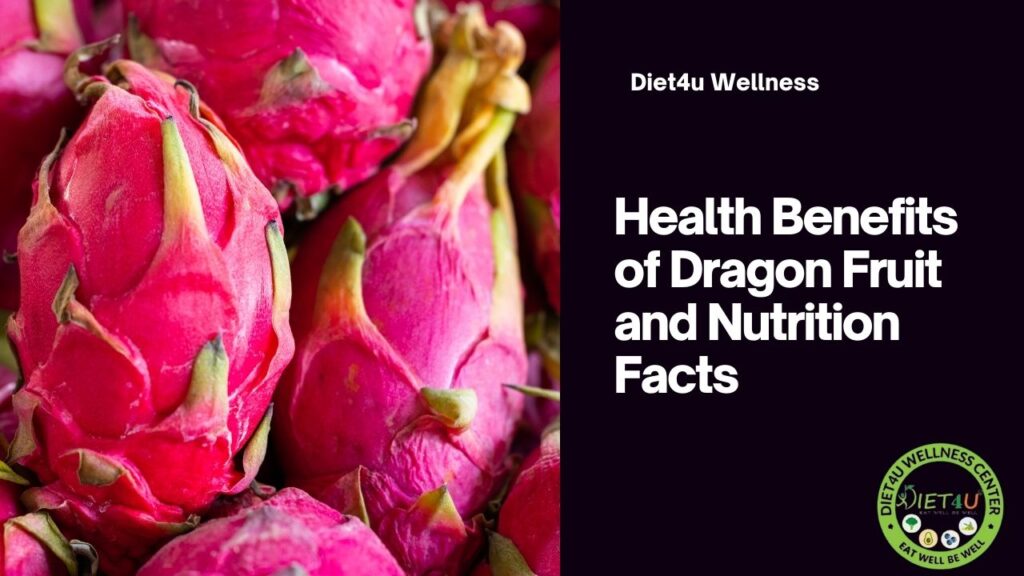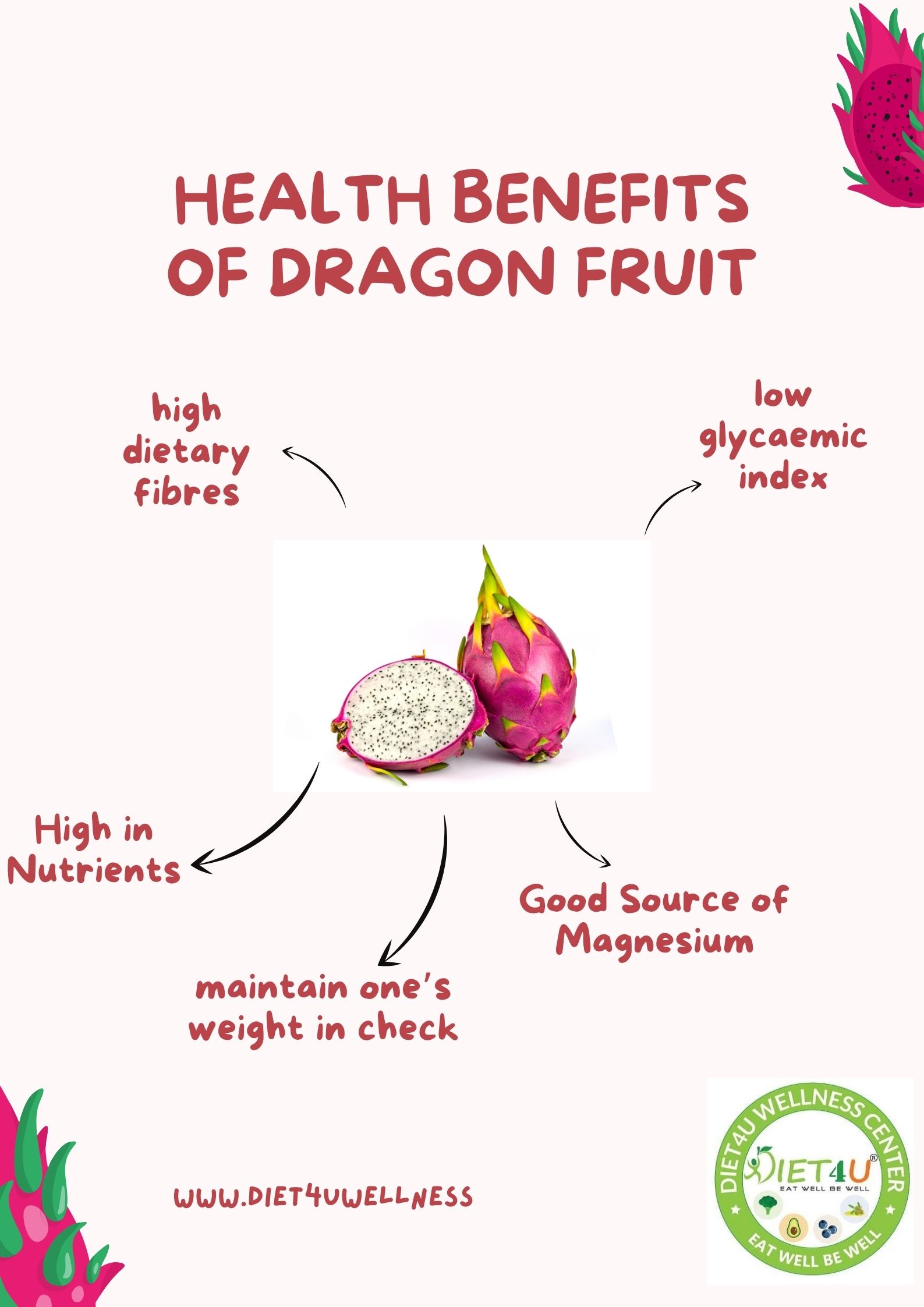
Health Benefits of Dragon fruit and Nutrition Facts
Table of Contents
- 1 Health Benefits of Dragon fruit and Nutrition Facts
Dragon fruit is a tropical fruit, native to the Southern Mexico and Central America. In the recent 21st century, it is being widely cultivated worldwide with South-east Asia, India, Australia and USA being some of the major hubs. The increasing demand has led to its surge in cultivation, in these parts of the world.
It is a perennial, herbaceous creeper cactus. It has no as such specific weather conditions for its utmost growth or yield, making it easier to cultivate throughout the year. The fruit has a very eye-catching bright pink colour but its health benefits is the main reason for its demand and popularity globally, in the recent times. This, exotic looking fruit from the Central America has immense health benefits and is mainly of two types. Out of the two types, the one with while pulp with black seeds is the most common one, with another rare type having pink pulp with black seeds.
Growing Dragon Fruits
Dragon fruits are meant to grow in the hot and humid tropical climate of the world with an average temperature of 20-29C but can also tolerate upto 38-40C. This makes it flexible to be grown at different parts of India, as well. It can be easily grown from stem-cutting method, like rose. This also brings down the cost of the cultivation, preventing the need of buying new saplings every time.
Nutrition Facts
With the increase in demand, one might wonder its nutritional facts and benefits. This surge in its demand is due to the presence of all sorts of nutrients in minute amounts, along with being rich in iron, magnesium and high fibre content.
100 grams of dragon fruit contains: [DV= Daily Value]
- Fat: 0.14g
- Protein: 0.36g
- Carbohydrates: 15g
- Fibre: 3g
- Iron: 1% of DV
- Magnesium: 2% of the DV
- Vitamin: 5% of the DV
- Total Calories: 57
Antioxidants in dragon Fruit
It is widely consumed because of its high amount of antioxidants. Antioxidants help in getting rid of the harmful free radicals that are being created naturally, due to normal metabolic reactions in the body. Free radicals like superoxide, hydrogen peroxide if produced in excess, can give rise to “oxidative stress”. Oxidative stress can alter the cell membrane structure, fluidity and also effects proteins, lipids, lipoproteins and even DNA. Build-up of such free radicals can lead to premature aging and several other disorders. For more information contact us.
Some of the antioxidants present in dragon fruits are:
Antioxidants present in the dragon fruit help in negating the adverse effects of the harmful free radicals which are formed during the normal metabolic functions. Thus preventing several inflammatory ailments in the body like gout and arthritis.
- Betalains: Betalains is an alkaloid. This is the cause for the “red pigment” of the dragon fruits. These are known to protect against the bad “LDL” and inhibits is oxidation, hence preventing it from causing any oxidative damage. Betacyanin is the red-coloured betalain, giving the fruit the red-pigment. Whereas, betaxanthins is a betalain, which gives the fruit a yellow tint. Yellow dragon fruit is extremely rare, hence priceless.
- Hydroxycinnamates: These are phenylpropanoids, a class of aromatic amino acids. It gives a sweet taste and floral scent. These phytochemical present in it, are known to have an anti-cancer activity.
- Flavonoids: These are a group of phenolic compounds, which help in improving the heart health.
- Lycopene: This phytochemical is also present in tomatoes. Lycopenes protect the body from chemicals and harmful toxins. Thus, helps in lowering the risk of cardiac disorders and cancer as well.
Glycaemic Control:
Dragon fruit when ripe, is sweet in taste. Due to its sweet taste, it might seem to be harmful for diabetics or pre-diabetics. However, it has a low glycaemic index, which makes sure that it does not cause any spike in the blood glucose level. According to scientific research, it has been shown that there has been a relation between dragon fruit consumption and a better control of diabetes. Dragon fruit consumption, facilitates the pancreatic beta cells to produce an increased level of insulin in the body. Due to higher levels of insulin, it helps in maintain the blood-glucose level, hence controlling the diabetes.
Health Benefits of Dragon Fruit

- It contains high dietary fibres. Therefore it helps in maintaining regular bowel movement.
- The fruit also have a low glycaemic index (as discussed earlier in the DIET4U WELLNESS article), hence prevents spike in blood-glucose level, if consumed in moderation.
- It has also shown, to maintain one’s weight in check and helps against fatty liver, also keeping the gut bacteria in check.
How to eat a Dragon Fruit?
By the mere look of it, dragon fruit might look very intimidating. The consumption of dragon fruits however, is fairly simple.
-
- The ripe dragon fruit can be plucked from the cactus bush, sliced into pieces and eaten directly. Eventhough the entire pink or white pulp of the fruit is completely laid with black seeds, considering their minute size, the seeds can be easily eaten and digested as well.
- To oomph up the consumption, the ripe fruit can be cut into thin slices and complemented with yoghurt or curd along with other fruits.
- The sliced up pieces of the fruit can also be added to a bowl of oatmeal along with a handful nuts to give it a slight crunch.
- In cases, where the fruit has become too ripe to be eaten directly, one can consider making a smoothie out of it. Further to improve the texture, a banana could be added along with pieces of it. Both the fruits would give the smoothie a sweet taste, all natural.
- And lastly, dragon fruit along with other fruits can be cut into pieces to make a bowl of fruit salad.
Side-effects of Dragon fruit:
Due to its exotic appearance, sweet taste and immense health benefits, it is being widely consumed world-wide. However, excess of anything is eventually detrimental. Eventhough it is known to have a low GI, excess consumption of dragon fruit might lead to considerable surge in glucose level.
Some people are known to have allergies as well. In such people, the dragon fruit acts as an antigen, which gets acted upon by the immunoglobulins, thus generating a regular allergic reaction. The allergies lead to swelling of tongue, development of hives, fever and even vomiting. For more queries call Diet4u wellness
FAQs Related to Dragon Fruit
-
What is the special feature of dragon fruit?
It has many health benefits, like its immense anti-oxidant compounds like flavonoids, phenolic acids, Betacyanin and hydroxycinnamtes.
-
What to avoid while eating dragon fruit?
Research has showed that, consumption of dragon fruit might interfere with the regular diabetes medicines. So, consumption of dragon fruits along with diabetes medicines, often tend to lower the blood glucose level. Dragon fruits have low glycaemic index which interacts with the lowering of blood-glucose property of diabetic drugs.
-
Is dragon fruit pregnancy safe?
Yes, it is absolutely safe during pregnancy. Rather, Dt. Rukhsana Azhar recommends eating dragon fruit during pregnancy, due to its high nutritional value and its high antioxidant properties. To know about the nutritional benefits of the fruit, one should follow and keep a check on the DIET4U WELLNESS page.
-
Which is the perfect season for dragon fruit?
Even though it is available throughout the year globally, however its best season is summer (June-September). During these months the fruit gets ripe perfectly, and is sweetest in taste during these months.

Hello My Name is Dt. Ruksana Azhar and I am a certified dietician and providing online & offline services for Weight Management, PCOS/PCOD Management, Diabetes Management , etc. I have 12+ years of experience in the Apollo Hospital Delhi , Max Super Specialty Hospital Delhi, Lilavati Hospital Mumbai and VLCC healthcare Mumbai. I loves to write healthcare and lifestyle related blog. My favorite part of being a doctor is the opportunity to directly improve the health and wellbeing of my patients and to develop professional and personal relationships with them.



